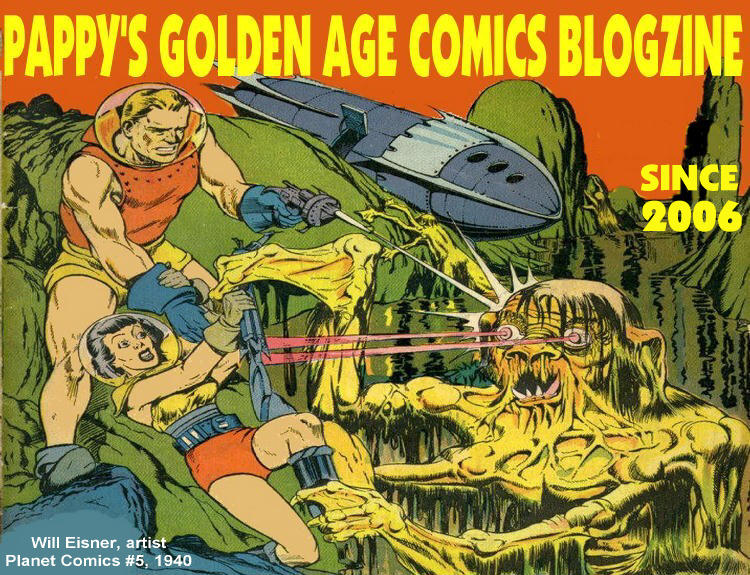In “Hail the King,” the plot by writer/artist Dick Briefer hangs on the gimmick — introduced for this story — of Frankenstein’s signature disappearing shortly after writing it. There is a slug in the last panel that says, “Thanks to Ed Goggin for help on these tales. Dick Briefer.” Maybe I can blame Ed. I am not a hardcore consistency freak, but such a gimmick appears thrown in.
I do like the two-headed girl. Dick Briefer could draw some mighty pretty girls when he wanted to.
From Frankenstein #8 (1947).












9 comments:
Well, the final panel essentially reveals that Frankenstein has simply been pulling the legs of the two … uhm … females here. His signature doesn't disappear as a result of how he was made, but as a result of his using disappearing ink. The tale of the origin of the back-scratcher is a fabrication on his part. So we don't have some new power out-of-the-blue; we have a practical joke; or, if you prefer, a trick of stage magick.
"Frankie, yoooooooouuuuuuu send me..."
I'm of two minds about trendy language in comics. On the one hand, it makes the story an artifact of its time, allowing the reader a glimpse at another era. On the other hand, it dates the comic, lessening its potential as a timeless piece of art.
Does the ending mean Frankie made up the story? And why would he want the women to think his writing "mysteriously" disappeared? Pretty dumb and vague.
I just started reading The Monster of Frankenstein, a collection of Briefer's later serious stories. The book is printed in black and white, which detracts a bit from the comics, but not as much as it would've from the funny strips. Anyway, it's hard to believe the humorous comics and the horror versions were written and drawn by the same guy; the later ones are so dark and brutal, but still really good. One funny thing, though I'm sure unintentional, about the horror comics: in the last panel of the first story, there's a caption of the monster's thoughts, which reads "This is not the end!" Then, at the bottom of the panel, it reads "The End."
That was ... a hard read. It had entertainment value, but as you say, it all hangs on this gimmick that doesn't even make the thinnest of sense. Briefer seemed to rush the art on this one a bit, too.
That said, still some good gags. The "who said I washed it" was one.
Love Dick Briefer! So glad they finally collected his Frank work. I remember seeing a non-Frank horror story with a bunch of crows or ravens, hope to find it again. Thanks for posting!
Ryan, I have that book, and even though I have most of the later Frankenstein comics, either in print or as scans, I still like looking at it. You might be too young to remember that a couple of decades ago most of what reprints we got of old public domain comics were done in black and white; color printing was too expensive.
Thank goodness for publishers like IDW, Dark Horse, Fantagraphics and others, who have found ways to preserve old color comics in book form!
Rich Clabaugh, that doesn't ring a bell...do you remember if that story by Briefer was from a horror comic, like by Atlas?
Daniel, I hang my head in shame. I knew the ending yet I went on with my complaint in my comment. From the tone I was probably having a crappy day when I wrote it.
Brian, while I wouldn't give Briefer high marks for hilarity, his gag sense was not bad. He sometimes had other writers help him, and I don't know how much of the jokes were his or by others. Going back through his comic book career, much of what he did that appeals to me is fairly light and amusing.
Was the story Rich is recalling "The Black Crows" from Mystery Tales #17 (June 1954)?
Post a Comment